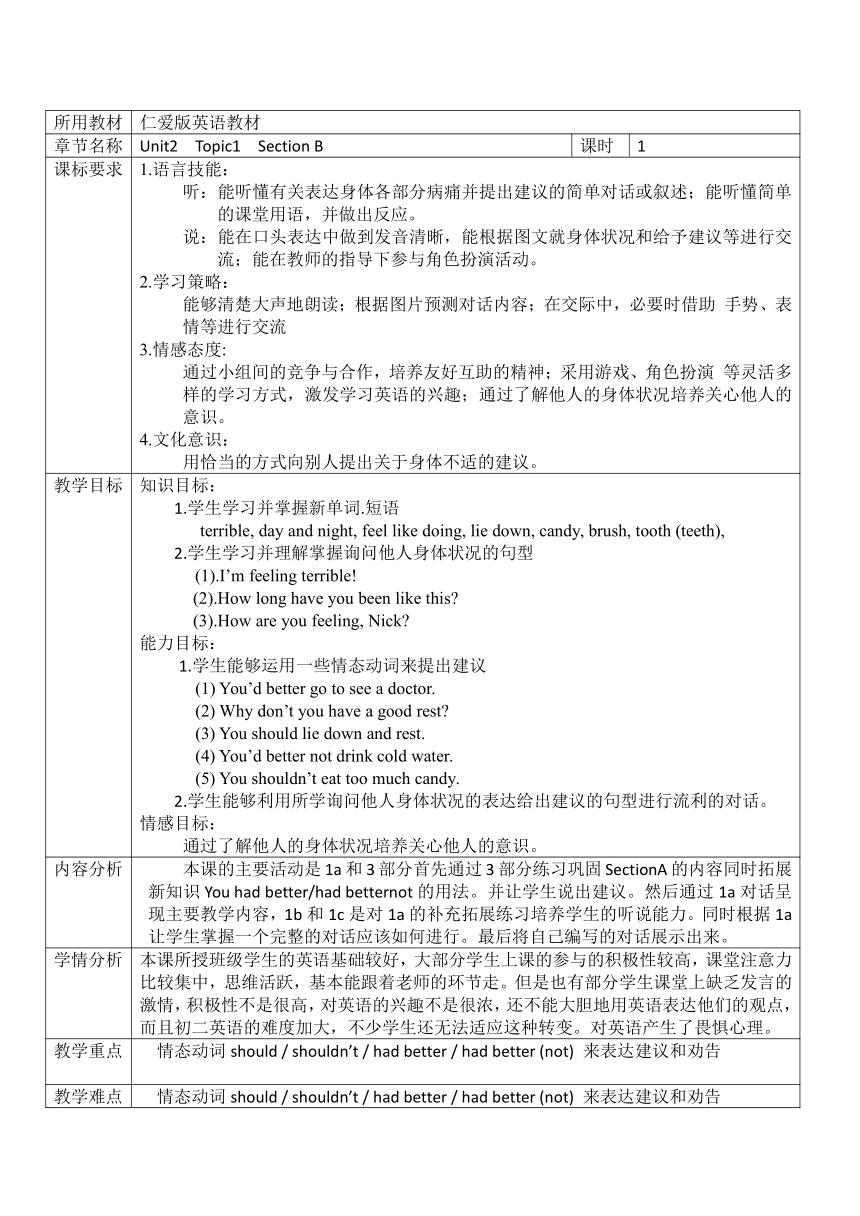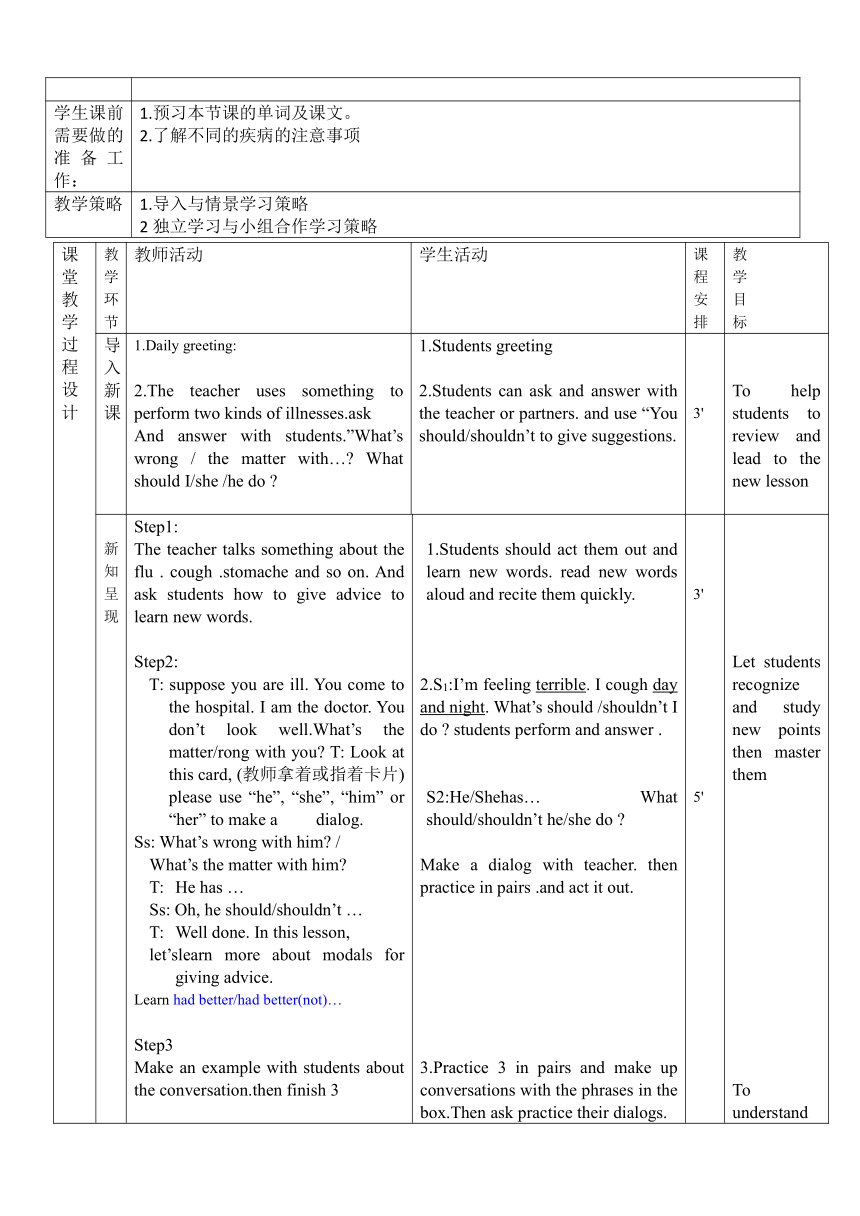Unit2 Topic1 You should brush your teeth twice a day. SectionB 表格式教案
文档属性
| 名称 | Unit2 Topic1 You should brush your teeth twice a day. SectionB 表格式教案 |

|
|
| 格式 | doc | ||
| 文件大小 | 74.5KB | ||
| 资源类型 | 教案 | ||
| 版本资源 | 仁爱科普版 | ||
| 科目 | 英语 | ||
| 更新时间 | 2022-10-09 22:16:40 | ||
图片预览


文档简介
所用教材 仁爱版英语教材
章节名称 Unit2 Topic1 Section B 课时 1
课标要求 语言技能:听:能听懂有关表达身体各部分病痛并提出建议的简单对话或叙述;能听懂简单的课堂用语,并做出反应。说:能在口头表达中做到发音清晰,能根据图文就身体状况和给予建议等进行交流;能在教师的指导下参与角色扮演活动。学习策略:能够清楚大声地朗读;根据图片预测对话内容;在交际中,必要时借助 手势、表情等进行交流情感态度:通过小组间的竞争与合作,培养友好互助的精神;采用游戏、角色扮演 等灵活多样的学习方式,激发学习英语的兴趣;通过了解他人的身体状况培养关心他人的意识。4.文化意识:用恰当的方式向别人提出关于身体不适的建议。
教学目标 知识目标: 1.学生学习并掌握新单词.短语terrible, day and night, feel like doing, lie down, candy, brush, tooth (teeth), 2.学生学习并理解掌握询问他人身体状况的句型 (1).I’m feeling terrible! (2).How long have you been like this (3).How are you feeling, Nick 能力目标: 1.学生能够运用一些情态动词来提出建议 (1) You’d better go to see a doctor.(2) Why don’t you have a good rest (3) You should lie down and rest.(4) You’d better not drink cold water.(5) You shouldn’t eat too much candy.2.学生能够利用所学询问他人身体状况的表达给出建议的句型进行流利的对话。情感目标:通过了解他人的身体状况培养关心他人的意识。
内容分析 本课的主要活动是1a和3部分首先通过3部分练习巩固SectionA的内容同时拓展新知识You had better/had betternot的用法。并让学生说出建议。然后通过1a对话呈现主要教学内容,1b和1c是对1a的补充拓展练习培养学生的听说能力。同时根据1a让学生掌握一个完整的对话应该如何进行。最后将自己编写的对话展示出来。
学情分析 本课所授班级学生的英语基础较好,大部分学生上课的参与的积极性较高,课堂注意力比较集中,思维活跃,基本能跟着老师的环节走。但是也有部分学生课堂上缺乏发言的激情,积极性不是很高,对英语的兴趣不是很浓,还不能大胆地用英语表达他们的观点,而且初二英语的难度加大,不少学生还无法适应这种转变。对英语产生了畏惧心理。
教学重点 情态动词should / shouldn’t / had better / had better (not) 来表达建议和劝告
教学难点 情态动词should / shouldn’t / had better / had better (not) 来表达建议和劝告
学生课前需要做的准备工作: 1.预习本节课的单词及课文。 2.了解不同的疾病的注意事项
教学策略 1.导入与情景学习策略2独立学习与小组合作学习策略
课堂教学过程设计 教学环节 教师活动 学生活动 课程安排 教学目标
导入新课 Daily greeting:2.The teacher uses something to perform two kinds of illnesses.ask And answer with students.”What’s wrong / the matter with… What should I/she /he do 1.Students greeting2.Students can ask and answer with the teacher or partners. and use “You should/shouldn’t to give suggestions. 3' To help students to review and lead to the new lesson
新知呈现 Step1:The teacher talks something about the flu . cough .stomache and so on. And ask students how to give advice to learn new words.Step2:T: suppose you are ill. You come to the hospital. I am the doctor. You don’t look well.What’s the matter/rong with you T: Look at this card, (教师拿着或指着卡片) please use “he”, “she”, “him” or “her” to make a dialog.Ss: What’s wrong with him /What’s the matter with him T: He has …Ss: Oh, he should/shouldn’t …T: Well done. In this lesson,let’slearn more about modals for giving advice.Learn had better/had better(not)…Step3Make an example with students about the conversation.then finish 3Step4: T: Boys and girls, we have learnt some modals for giving advice. Now let’s look at the picture in 1a and guess what happened to Bruce. Then listen to 1a and choose the correct answers.Step5. listen to 1a again and mark T or F.Step6T: Now, listen to 1a again and repeat. Pay attention to the pronunciation and intonation.Step7:Ask students to find out difficult and important points in the dialog.and explain them. 1.Students should act them out and learn new words. read new words aloud and recite them quickly. 2.S1:I’m feeling terrible. I cough day and night. What’s should /shouldn’t I do students perform and answer .S2:He/Shehas… What should/shouldn’t he/she do Make a dialog with teacher. then practice in pairs .and act it out.3.Practice 3 in pairs and make up conversations with the phrases in the box.Then ask practice their dialogs.4.Students listen and choose the correct answers. Then check answers.5.listen to 1a again and mark T or F.. then check answers.6.listen to 1a again and repeat.and pay attention to the pronunciation and intonation7.students find out the difficult and important points in the dialog .Then some of the students stand up and say out. 3'5'15' Let students recognize and study new points then master themTo understand useful expressions and practicecorrectly
当堂训练 Step1Let students read 1a and fill in the blanks .Step2:let students finish 2.Number the sentences to make up a conversation silimar to 1a.Step3:According to 1a and 2 to make up a new dialog by themselves. 1.students read 1a by themselves and fill in the blacks .then answer it.and read it together.2.students Number the sentences to make up a conversation silimar to 1a.then read it together in correct order.3. make up a new dialog by themselves. And perform some dialogs. 7' To master a dialog and students are able to make new dialogs
拓展延伸 T: Suppose you are ill, you go to see a doctor. Make a dialog between you and the doctor. The following expressions can help you.How are you feeling What’s wrong = What’s the matter Not so well. (I’m feeling terrible.)How long have you been like this feel like doing Example:S1: What’s wrong with you, S2 S2: I’m feeling terrible … 5' To improve the students comprehensive ability
课后巩固 students use “should / shouldn’t /had better / had better not “ to make sentences. use “should / shouldn’t /had better / had better not “ to make sentences. 2' To master this lesson
思 路 达标检测 教学目标 测试题目内容
考察基础知识的掌握 适当形式填空1.Why don’t you __________(take) some medicine 2.I don’t feel like __________(eat).3.How long have you ________(be) like this
考察对情态动词的运用 翻译句子.1.你不应该吃太多的糖。______________________________2.你最好躺下休息。 ________________________________
板书设计 Unit2 Topic1 You should brush your teeth twice a day. Section B 1. What’s wrong /the matter with you medicine 2. I’m feeling terrible . suggestion 3. How long have you been like this candy 4. had better (not) do sth. lie down 5. feel like doing sth. Would like to do sth Want to do sth
教学反思 亮点: 本节课教学目标明确,教学环节、教学时间安排合理,教学思路清晰。在课堂活动设计中,体现了教材的整体性概念。本课是对话教学及语法随机集中教学,引导学生整体理解、分析、归纳语言材料,局部理解、探究,解决具体语言点,从整体出发,回到整体中去。利用计算机和多媒体辅助教学, 探索新的教学模式。教学英语单词, 调动视觉、听觉功能, 提高单词记忆效率。通过丰富、生动的图片呈现, 创设活灵活现的情境,使学生在轻松愉悦的氛围里感知、理解新语言材料,综合应用所学知识, 完成表层信息输入和深层信息理解、既拓宽学生的眼界,又增加课容量,提高课堂教学效果。不足: 课堂气氛调动的不是很活跃,时间紧,设计的活动多显得比较仓促,没有进行跟录音模仿着读,所以在矫正学生读音上有点弱,需要进一步强化,为了完成教学任务,学生进行小组活动的时候给留的时间有点少。
章节名称 Unit2 Topic1 Section B 课时 1
课标要求 语言技能:听:能听懂有关表达身体各部分病痛并提出建议的简单对话或叙述;能听懂简单的课堂用语,并做出反应。说:能在口头表达中做到发音清晰,能根据图文就身体状况和给予建议等进行交流;能在教师的指导下参与角色扮演活动。学习策略:能够清楚大声地朗读;根据图片预测对话内容;在交际中,必要时借助 手势、表情等进行交流情感态度:通过小组间的竞争与合作,培养友好互助的精神;采用游戏、角色扮演 等灵活多样的学习方式,激发学习英语的兴趣;通过了解他人的身体状况培养关心他人的意识。4.文化意识:用恰当的方式向别人提出关于身体不适的建议。
教学目标 知识目标: 1.学生学习并掌握新单词.短语terrible, day and night, feel like doing, lie down, candy, brush, tooth (teeth), 2.学生学习并理解掌握询问他人身体状况的句型 (1).I’m feeling terrible! (2).How long have you been like this (3).How are you feeling, Nick 能力目标: 1.学生能够运用一些情态动词来提出建议 (1) You’d better go to see a doctor.(2) Why don’t you have a good rest (3) You should lie down and rest.(4) You’d better not drink cold water.(5) You shouldn’t eat too much candy.2.学生能够利用所学询问他人身体状况的表达给出建议的句型进行流利的对话。情感目标:通过了解他人的身体状况培养关心他人的意识。
内容分析 本课的主要活动是1a和3部分首先通过3部分练习巩固SectionA的内容同时拓展新知识You had better/had betternot的用法。并让学生说出建议。然后通过1a对话呈现主要教学内容,1b和1c是对1a的补充拓展练习培养学生的听说能力。同时根据1a让学生掌握一个完整的对话应该如何进行。最后将自己编写的对话展示出来。
学情分析 本课所授班级学生的英语基础较好,大部分学生上课的参与的积极性较高,课堂注意力比较集中,思维活跃,基本能跟着老师的环节走。但是也有部分学生课堂上缺乏发言的激情,积极性不是很高,对英语的兴趣不是很浓,还不能大胆地用英语表达他们的观点,而且初二英语的难度加大,不少学生还无法适应这种转变。对英语产生了畏惧心理。
教学重点 情态动词should / shouldn’t / had better / had better (not) 来表达建议和劝告
教学难点 情态动词should / shouldn’t / had better / had better (not) 来表达建议和劝告
学生课前需要做的准备工作: 1.预习本节课的单词及课文。 2.了解不同的疾病的注意事项
教学策略 1.导入与情景学习策略2独立学习与小组合作学习策略
课堂教学过程设计 教学环节 教师活动 学生活动 课程安排 教学目标
导入新课 Daily greeting:2.The teacher uses something to perform two kinds of illnesses.ask And answer with students.”What’s wrong / the matter with… What should I/she /he do 1.Students greeting2.Students can ask and answer with the teacher or partners. and use “You should/shouldn’t to give suggestions. 3' To help students to review and lead to the new lesson
新知呈现 Step1:The teacher talks something about the flu . cough .stomache and so on. And ask students how to give advice to learn new words.Step2:T: suppose you are ill. You come to the hospital. I am the doctor. You don’t look well.What’s the matter/rong with you T: Look at this card, (教师拿着或指着卡片) please use “he”, “she”, “him” or “her” to make a dialog.Ss: What’s wrong with him /What’s the matter with him T: He has …Ss: Oh, he should/shouldn’t …T: Well done. In this lesson,let’slearn more about modals for giving advice.Learn had better/had better(not)…Step3Make an example with students about the conversation.then finish 3Step4: T: Boys and girls, we have learnt some modals for giving advice. Now let’s look at the picture in 1a and guess what happened to Bruce. Then listen to 1a and choose the correct answers.Step5. listen to 1a again and mark T or F.Step6T: Now, listen to 1a again and repeat. Pay attention to the pronunciation and intonation.Step7:Ask students to find out difficult and important points in the dialog.and explain them. 1.Students should act them out and learn new words. read new words aloud and recite them quickly. 2.S1:I’m feeling terrible. I cough day and night. What’s should /shouldn’t I do students perform and answer .S2:He/Shehas… What should/shouldn’t he/she do Make a dialog with teacher. then practice in pairs .and act it out.3.Practice 3 in pairs and make up conversations with the phrases in the box.Then ask practice their dialogs.4.Students listen and choose the correct answers. Then check answers.5.listen to 1a again and mark T or F.. then check answers.6.listen to 1a again and repeat.and pay attention to the pronunciation and intonation7.students find out the difficult and important points in the dialog .Then some of the students stand up and say out. 3'5'15' Let students recognize and study new points then master themTo understand useful expressions and practicecorrectly
当堂训练 Step1Let students read 1a and fill in the blanks .Step2:let students finish 2.Number the sentences to make up a conversation silimar to 1a.Step3:According to 1a and 2 to make up a new dialog by themselves. 1.students read 1a by themselves and fill in the blacks .then answer it.and read it together.2.students Number the sentences to make up a conversation silimar to 1a.then read it together in correct order.3. make up a new dialog by themselves. And perform some dialogs. 7' To master a dialog and students are able to make new dialogs
拓展延伸 T: Suppose you are ill, you go to see a doctor. Make a dialog between you and the doctor. The following expressions can help you.How are you feeling What’s wrong = What’s the matter Not so well. (I’m feeling terrible.)How long have you been like this feel like doing Example:S1: What’s wrong with you, S2 S2: I’m feeling terrible … 5' To improve the students comprehensive ability
课后巩固 students use “should / shouldn’t /had better / had better not “ to make sentences. use “should / shouldn’t /had better / had better not “ to make sentences. 2' To master this lesson
思 路 达标检测 教学目标 测试题目内容
考察基础知识的掌握 适当形式填空1.Why don’t you __________(take) some medicine 2.I don’t feel like __________(eat).3.How long have you ________(be) like this
考察对情态动词的运用 翻译句子.1.你不应该吃太多的糖。______________________________2.你最好躺下休息。 ________________________________
板书设计 Unit2 Topic1 You should brush your teeth twice a day. Section B 1. What’s wrong /the matter with you medicine 2. I’m feeling terrible . suggestion 3. How long have you been like this candy 4. had better (not) do sth. lie down 5. feel like doing sth. Would like to do sth Want to do sth
教学反思 亮点: 本节课教学目标明确,教学环节、教学时间安排合理,教学思路清晰。在课堂活动设计中,体现了教材的整体性概念。本课是对话教学及语法随机集中教学,引导学生整体理解、分析、归纳语言材料,局部理解、探究,解决具体语言点,从整体出发,回到整体中去。利用计算机和多媒体辅助教学, 探索新的教学模式。教学英语单词, 调动视觉、听觉功能, 提高单词记忆效率。通过丰富、生动的图片呈现, 创设活灵活现的情境,使学生在轻松愉悦的氛围里感知、理解新语言材料,综合应用所学知识, 完成表层信息输入和深层信息理解、既拓宽学生的眼界,又增加课容量,提高课堂教学效果。不足: 课堂气氛调动的不是很活跃,时间紧,设计的活动多显得比较仓促,没有进行跟录音模仿着读,所以在矫正学生读音上有点弱,需要进一步强化,为了完成教学任务,学生进行小组活动的时候给留的时间有点少。
同课章节目录
- Unit 1 Playing Sports
- Topic 1 I'm going to play basketball.
- Topic 2 I'll kick you the ball again.
- Topic 3 The school sports meet is coming.
- Unit 2 Keeping Healthy
- Topic 1 You should brush your teeth twice a day.
- Topic 2 I must ask him to give up smoking.
- Topic 3 Must we exercise to prevent the flu?
- Unit 3 Our Hobbies
- Topic 1 What's your hobby?
- Topic 2 What sweet music!
- Topic 3 What were you doing at this time yesterday
- Unit 4 Our World
- Topic 1 What's the strongest animal on the farm?
- Topic 2 How can we protect ourselves from the eart
- Topic 3 The Internet makes the world smaller.
